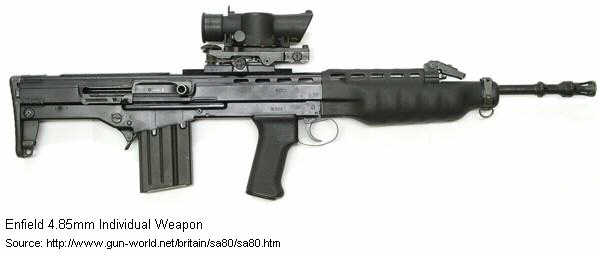During the 1960s, the United Kingdom experimented with creating a lightweight but effective replacement for the 7.62×51mm NATO round. Their original experiments focused on a .280 British round necked downed to 6.3mm. However, in the 1960s, a West German study proposed that an ideal cartridge would have a 5mm or smaller caliber. The results of this study encouraged the United Kingdom switch to using a 5mm caliber bullet for their experimental cartridge. The requirement for a 5mm round for what would be the SA80 sealed the idea that a 5mm round needed to be made.
The 4.85×49mm originally started off as the 5×44mm round, which was made in 1970. The bullet shape used in these early prototypes were based on one used by the 6.25×43mm round, another experimental British round. The actual cases were made from reformed 5.56 NATO rounds. However, it was soon decided that the round would be renamed to “4.85×44mm” in order to match the diameter of the test gun barrel’s lands The actual diameter of the round didn’t change.
Continued tests showed that there were problems with bullet seating. To fix this, the round’s neck was elongated 5mm to create the 4.85×49mm round. However, before the production lines were fully retooled for the new round, RSAF Enfield required a batch of ammo for testing. Existing 4.85×44mm rounds had their neck manually stretched out 5mm in order to qualify for the test.
Tests with both the 4.85×49mm round and the L64/65 continued throughout the 1970s. In 1976, the L64/L65 weapon system was officially announced, revealing the first time that the public officially knew about it and the 4.85mm cartridge. In 1977, trials to find a new cartridge and weapon for NATO standardization went underway. The United Kingdom submitted the IW weapon a 4.85×49mm. Lots of both the XL1E1 ball and XL2E1 tracer round were created in order to provide enough ammunition for the tests. The UK hoped that the United States and NATO would see the inherent advantages the 4.85 round had over the 5.56 round and adopt it.
The 4.85mm’s lifespan came to an end when the ending results of the NATO tests concluded that the FN Herstal SS109 bullet for the 5.56mm had the best performance. In 1979, British testers formally scrapped the 4.85mm round in favor of the 5.56mm round. The IW system was subsequently rechambered to 5.56mm. (Wikipedia)





 Tracer
Tracer

 Proof loading with red base
Proof loading with red base

 Short range
Short range

 Blank
Blank

 Ball
Ball

 Dummy
Dummy

